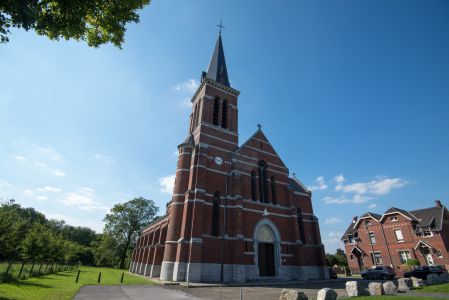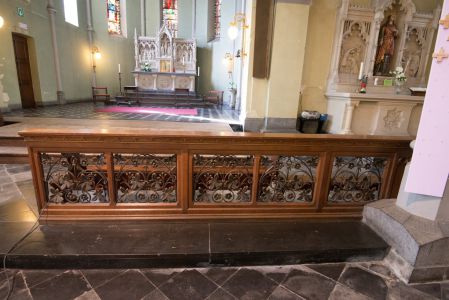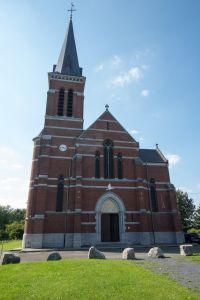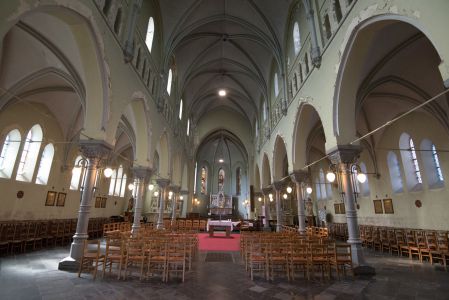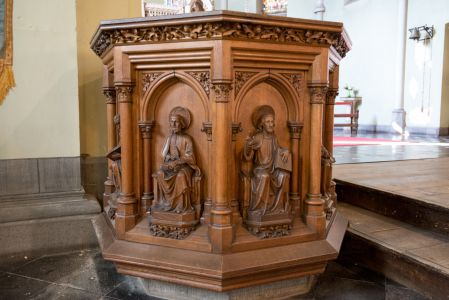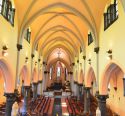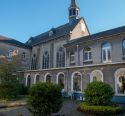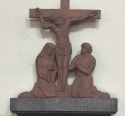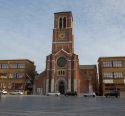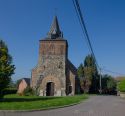Church | 1905 | Neogothic | Catholic Church


Map
Opening hours
01 April - 31 October
Mon -
Tue -
Wed -
Thu -
Fri -
Sat -
Sun 14.00 - 17.00
or by arrangement :
+32 478 69 57 06 and +32 476 31 73 37
Religious offices
2nd and 4th Sunday : 10 am
Feast of St-Barba : nearliest Sunday from 4 december : 10 am
Description
The church is interesting, not for itself, but as a piece in a remarkable ensemble; the mining area of Bois-du-Luc which, along with the Grand-Hornu, Bois du Cazier and Blegny-Mine, is an important example of collieries of the industrial period, listed as a UNESCO World Heritage Site in 2012. The site comprises the mining installations, miners’ homes in the mining villages, the managers’ houses, the administration buildings, a hospital, a community hall and a church.
This church is, appropriately, dedicated to Saint Barbe, the patron of miners. Its architect is Constant Sonneville and it is in Neo-Gothic style like many churches of this period. It is in red brick and inside, apart from the usual devotional objects, are cast iron columns, significant in an industrial environment. A nearby ecological museum is worth a visit.
The area is also listed as an important Walloon heritage site.
Photos
Remarkable elements
Medieval tympanum
Above the portal, a tympanum in the medieval style groups the four Evangelists around Christ in glory.
Banners
The church has a double velvet banner, embellished with silk and gold threads. One is dedicated to the Blessed Virgin. The other is dedicated to Saint Barbara, the church's patron saint. At the top left, a coat of arms displays the attributes of the martyred saint: the tower, the palm and the sword. At the top right is the coat of arms of Hainaut.
At the bottom are two figures dressed as miners: Omar Degueldre, director, and Charles Demeure, engineer, carrying the church of Sainte-Barbe.
Cast-iron columns
The cast-iron columns are topped with decorated capitals. They were cast in the colliery's workshops.
Furniture
As soon as you cross the threshold, you are immediately struck by the harmony of the church's interior.
The French stone altarpieces on the three altars are in perfect harmony with the figures on the pulpit and the tympanum at the entrance.
The vat from the pulpit is preserved in the choir.
A beautiful wooden and wrought iron communion bench highlights the architectural ensemble. Fortunately, it has remained in place, preserving the original character of the building.
The small rosettes of various shapes on the altars, the communion bench, the confessionals, the Way of the Cross and the light fittings give the sanctuary a harmonious unity.
Priestly vestments
The church has a fine collection of priestly vestments in various liturgical colours. A very fine set of gold-embroidered satin and burgundy velvet from the Maison Arte-Grossé in Bruges is used every year on the feast of Saint Barbara: a chasuble and cope with orphreys in the effigy of Saint Barbara, two dalmatics, a stole-cape and a chalice veil.
Several black chasubles and copes stand out for the finesse of their embroidery.
All the ornaments are in an excellent state of preservation.
Bells
The two bells were cast at the Bochum steelworks in Germany.
The larger bell, in F, was donated by the manager, Omer Degueldre. It bears the names Cécilia, Liévine and Fernand. It weighs 960 kg.
The second, in A, was donated by the Demeure family. Its names are Charles, Marie, Albert, Aliicie, Berthe and Adolphe. It weighs 460 kg.
An electrical system was installed in 1950.


